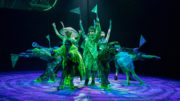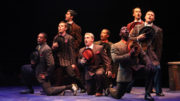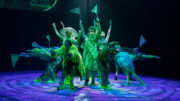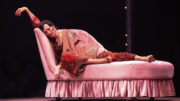 photo by Charr Crail
photo by Charr Crail
—by Jeff Hudson
 The 2015 Music Circus season opened on Tuesday, June 9 with a one-week run of My Fair Lady, the Lerner and Loewe show that has long been one of the staples of the venerable summer series.
The 2015 Music Circus season opened on Tuesday, June 9 with a one-week run of My Fair Lady, the Lerner and Loewe show that has long been one of the staples of the venerable summer series.
My Fair Lady, which premiered in 1956, makes just about everybody’s short list of “classics from Broadway’s Golden Age.” Music Circus first staged My Fair Lady in 1964 (the year the movie version came out), and restaged the show two more times in the ‘60s, followed by only one production in the ‘70s, and one more in the ‘80s—which was probably not coincidental, since the show’s presentation of the elitist Prof. Henry Higgins re-molding the personality of lower-class flower girl Eliza Doolittle rankled feminists in those decades as coming too close to cruel mind control. Nowadays, the show is seen as something of a beloved blast from the past, and valued primarily for its glorious score. As the “content guide” provided by the Music Circus demurely puts it, “[My Fair Lady] includes no violence or sexual situations. It does include references to excessive alcohol consumption and antiquated views on women’s rights and roles, and some of the plot elements focus on relationships.” All of which is a nice way of saying that the show reflects middle-class American values about men, women and marriage from the 1950s (as well as the drinking habits of that era) that now appear out-of-date.
Let it be noted that these 1950s aspects of My Fair Lady do not mesh with the content in the play upon which the musical is based—George Bernard Shaw’s Pygmalion, which premiered in 1913. Shaw’s play included a lot of pointed satire of middle-class British values (especially in the scenes in which Cockney street philosopher Alfred Doolittle, Eliza’s dad, complains his life has been wrecked when he inherits a wad of money from an American benefactor). You can spot traces of Shaw’s wickedly funny dialog in the (shortened) speech that Alfred Doolittle gives in My Fair Lady’s second half. But the social satire soon opens out into an up-tempo production number (“Get Me To The Church On Time”). My Fair Lady also plays up a developing romantic interest between Henry Higgins and Eliza Doolittle that wasn’t really present in Shaw’s stage play.
Truth be told, Shaw’s views on the corrupting aspects of money and middle class materialism and the restricted role of women in society, are actually closer of the attitudes you’ll find in Hair, the “tribal rock musical” from the 1960s that will wrap up the Music Circus season later this summer, more than anything in My Fair Lady—but that is fodder for a different essay on another day.
Back to this Music Circus production. It is, of course, staged in the round, which leads to some changes in the standard proscenium presentation, like the horse racing scene, which (in a proscenium presentation) involves a group of society’s elite standing in a line and watching the horses go by. In this production, they stand in a circle. And director Glenn Casale opts not to use any of the Music Circus stage’s abilities to rotate or elevate in this production. The round stage is terra firma throughout this show.
The cast features a small platoon of professional musical theater talent, including well-chosen leads Paul Schoeffler (a Music Circus veteran, as Henry Higgins) and newcomer Glory Crampton (as Eliza Doolittle, making the transformation from flower-girl to “duchess” credible). Also Stephen Berger (salty Alfred Doolittle), William Parry (the ever loyal Col. Pickering, dramatic foil to Higgins), and Jason Forbach (who gets to sing the show’s best love song—twice—as Freddie Eynsford-Hill, but the role gives Forbach little else to do). You’ll also spot Omari Tau of the Sacramento State faculty in the ensemble.
Music director Craig Barna handles the capable pit orchestra skillfully, choreographer Bob Richard handles the transition to the small round stage without making the dance numbers feel downsized (even though they are). Hair/wig designer Jill Lane and costume designer Marcy Froehlich have plenty to do, and give the production a nice look. Scenic designers Scott Klier and Jamie Kumpf fly down book cases, archways and small chandeliers to imply Higgins study, scenes in the streets of London, and a formal ballroom, among other locations.
My Fair Lady is a core-repertoire classic that the Music Circus should do well, and this production lives up to that standard. I wouldn’t go so far as to say that this production is the very best of the 12 mountings of this musical that the Music Circus has staged during the past 50 years (and I certainly haven’t seen all 12 of them), but this year’s version is a solid and successful mounting, and represents good value for ticket buyers.
My Fair Lady , which has a three-hour running time, plays at 7:30 p.m. Wednesday through Saturday, and 2 p.m. on Thursday, Saturday and Sunday, at the Wells Fargo Pavilion, 1419 H Street. Tickets are $40-$83, and can be purchased at (916) 557-1999 or www.tickets.com. The show closes on Sunday, June 14.




